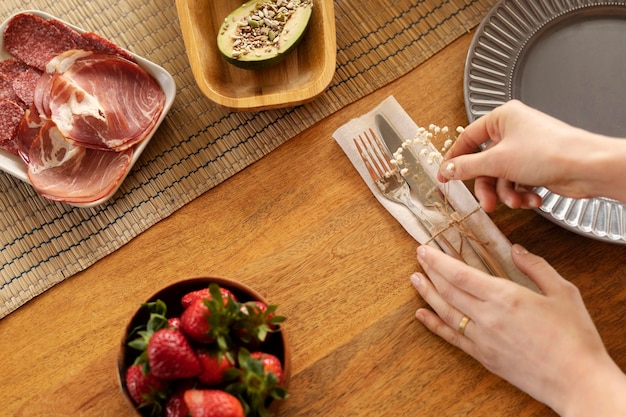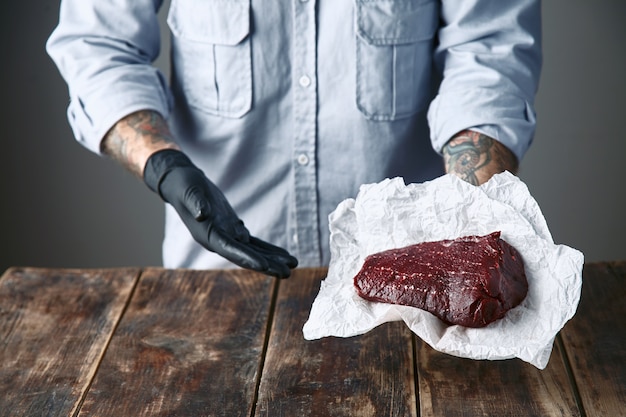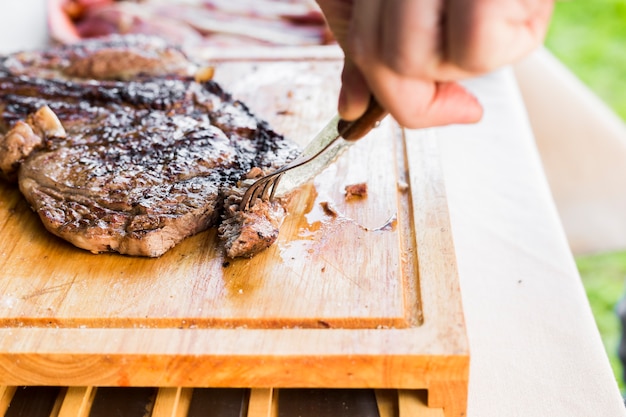The allure of a perfectly seared ahi tuna steak is undeniable. The rich, buttery flavour, the vibrant pink flesh, the satisfyingly crisp exterior - it's a taste of the tropics right on your plate. And while it might seem intimidating to cook, I promise you, it's surprisingly easy once you know a few tricks of the trade. Trust me, it's all about the right techniques, a bit of confidence, and a whole lot of deliciousness. So grab your favourite bottle of wine, put on some chill tunes, and get ready to impress yourself and your guests with this simple yet stunning dish.
(Part 1) The Essentials: Choosing and Prepping Your Tuna

The journey to perfect ahi tuna starts with the right cut. For me, a nice thick steak, around 1.5 inches (3.8 cm) thick, is the way to go. It provides a good surface area for searing, resulting in a beautiful, juicy centre. I usually head to my local fishmonger for the freshest catch, and I always look for steaks that are bright red with a firm texture. Avoid any that are dull in colour or have a fishy smell - that's a sign they might not be so fresh. Once you've got your prized steak, the prep is surprisingly simple.
1.1. Getting Started
First things first, pat the tuna dry with paper towels. This is super important - it removes any excess moisture that could interfere with the searing process. Think of it as preparing the surface for a perfect sear, just like you would with a steak. Next, give it a light drizzle of olive oil. This helps the tuna brown nicely and prevents it from sticking to the pan. I like to season with salt and pepper at this point, but feel free to get creative with your spice blends - a little bit of smoked paprika or cayenne pepper can add an extra kick.
1.2. The Art of Patting: It's All About That Dry Surface
You might think that patting a piece of tuna dry is a simple task, but it's surprisingly crucial. You want to ensure that there's absolutely no moisture on the surface of the tuna, because water will steam the fish rather than allowing it to sear properly. Think of it as creating a dry canvas for that beautiful, crisp crust. It should be perfectly dry and ready for the pan.
1.3. A Quick Dip for an Extra Kick: Taking the Flavour to the Next Level
For a touch of extra flavour, you can give your tuna steak a quick dip in soy sauce or a marinade of your choice. I've been known to use a mixture of soy sauce, sesame oil, ginger, and garlic for a more Asian-inspired flavour. If you're feeling adventurous, try a citrusy marinade with lime juice, olive oil, and fresh herbs. Whatever you choose, just make sure to pat the tuna dry again after marinating to ensure a proper sear. You want to make sure that the marinade doesn't create too much steam when it hits the hot pan.
(Part 2) The All-Important Sear: Mastering the Technique

The key to perfectly seared ahi tuna is getting that gorgeous, crispy crust without overcooking the inside. It's all about timing and heat control, and that's where the real magic happens. Here's what I've learned through years of experimenting in the kitchen:
2.1. Searing it Right: High Heat and Short Time
Start by heating a cast iron skillet or a heavy-bottomed pan over high heat. You want it smoking hot before you add the tuna. This ensures a quick sear that forms a crisp crust while keeping the inside moist and tender. The heat should be intense but controlled - you don't want the pan too hot as it will burn the tuna before it's had a chance to cook properly.
2.2. Don’t Crowd the Pan: Give That Tuna Some Space
The most common mistake people make is crowding the pan with too much tuna. This leads to uneven cooking and a soggy, rather than crispy, sear. Leave some space between each steak to allow for proper airflow and heat distribution. Ideally, you want the tuna to sizzle and not steam in the pan.
2.3. Listen to the Tuna: The Sounds of a Perfect Sear
Listen closely to the tuna as it cooks. You'll hear a distinct sizzling sound as it hits the hot pan. The sound will change as the tuna starts to cook through. As the sound becomes more muted, that's your cue to flip the tuna. A good rule of thumb is to sear each side for about 2-3 minutes, depending on the thickness of your steak.
(Part 3) Finishing Touches: Elevating Your Ahi Tuna

The sear is the foundation, but it’s the finishing touches that truly take your ahi tuna to the next level. From sauces to sides, there are countless ways to elevate this simple dish.
3.1. The Art of Resting: Letting the Tuna Relax
Once your tuna is seared, don't rush to slice it. Let it rest for 5-7 minutes to allow the juices to redistribute throughout the steak. This results in a more tender and evenly cooked final product. The resting time is crucial to prevent the tuna from drying out.
3.2. Sauce Up Your Tuna: Adding a Flavour Punch
A drizzle of good quality olive oil and a squeeze of fresh lemon juice is a classic combination for ahi tuna. It's simple, yet elegant. But don’t be afraid to experiment! A touch of soy sauce, a swirl of sesame oil, or a sprinkle of chili flakes can add a whole new dimension of flavour. If you're feeling adventurous, try a ponzu sauce for a tangy citrusy flavour.
3.3. Pairing it Right: Finding the Perfect Compliments
Ahi tuna is incredibly versatile and pairs well with a wide range of flavours. Here are some of my favourites:
- Asian Inspired: Combine it with a side of rice, edamame, and a vibrant Asian slaw for a light and refreshing meal. A sprinkle of toasted sesame seeds adds a nice crunch.
- Mediterranean Twist: Serve it with a side of roasted vegetables, couscous, and a drizzle of lemon vinaigrette for a delicious and healthy meal. The vibrant colours of the vegetables create a beautiful and appealing plate.
- Steakhouse Chic: Elevate the tuna to steakhouse status by serving it with creamy mashed potatoes, asparagus, and a rich, buttery sauce. This is a classic combination that's sure to impress your guests.
(Part 4) Don’t Forget the Sides: Complements to Your Tuna
Your ahi tuna deserves a side that complements its delicate flavour without overpowering it. Think of it as the supporting cast that brings out the best in the star of the show. Here are a few ideas to inspire you:
4.1. The Classic: Aromatic Rice
A simple bowl of white rice is a classic accompaniment for ahi tuna. It's a clean and neutral base that lets the tuna shine. But for a more sophisticated touch, you can try a flavoured rice like jasmine rice or basmati rice. You can also add a touch of flavour to your rice with aromatics like garlic, ginger, or scallions. A pinch of saffron adds a luxurious touch.
4.2. Summery Salad: A Light and Bright Choice
A light and refreshing salad with a vibrant dressing is the perfect complement to a rich and flavorful tuna steak. Think bright colours and fresh flavours. Choose ingredients like avocado, mango, cucumber, and cherry tomatoes for a sweet and savory flavour combination. A simple vinaigrette with olive oil, lemon juice, and herbs is a perfect match.
4.3. Roasted Vegetables: Adding Depth
Roasted vegetables bring a depth of flavour and texture to the dish. Think of it as adding a layer of complexity to the meal. Try roasting asparagus, broccoli, Brussels sprouts, or bell peppers. Season them with herbs and spices for a delicious and healthy side. A sprinkle of rosemary or thyme adds a touch of elegance.
(Part 5) Cooking the Tuna to Your Liking: Understanding Doneness
One of the most important aspects of cooking ahi tuna is understanding the different levels of doneness. You can cook it rare, medium rare, or even medium. It all comes down to personal preference. Think about how you like your steak and apply the same principle to your tuna.
5.1. Rare: A Touch of Pink
Rare tuna is the most common way to cook it. It has a vibrant red centre and a slightly cool touch. It's the most delicate and has a delicate, buttery flavour. If you're a fan of raw tuna, you'll love this level of doneness. The centre will be slightly translucent, like the centre of a perfectly cooked steak.
5.2. Medium Rare: Slightly Pinker
Medium rare tuna is a bit more cooked than rare, but it still has a touch of pink in the centre. The centre will have a darker, almost coral hue. It's a bit firmer and has a slightly more pronounced flavour. If you're not quite ready for rare, this is a good option.
5.3. Medium: Cooked Through
Medium tuna is cooked all the way through, and it has a firm texture and a deeper, more pronounced flavour. If you prefer your tuna fully cooked, this is the way to go. The centre will be fully opaque and have a more brownish colour. This is similar to a well-done steak.
5.4. A Quick Guide: Doneness vs. Time
Here’s a quick guide to the approximate cooking times for different levels of doneness. Remember, these are just guidelines. The actual cooking time will vary depending on the thickness of your tuna steak and the heat of your pan.
| Doneness | Cooking Time per side |
|---|---|
| Rare | 2-3 minutes |
| Medium Rare | 3-4 minutes |
| Medium | 4-5 minutes |
(Part 6) The Crucial Technique: Using a Thermometer
If you’re unsure about your cooking skills or just want to be extra sure that your tuna is cooked to your liking, using a meat thermometer is the most reliable way to ensure a perfect result. It’s an indispensable tool for anyone who wants to avoid overcooked or undercooked tuna.
6.1. The Importance of Precision
A meat thermometer takes the guesswork out of cooking. Simply insert the thermometer into the thickest part of the tuna steak, avoiding the bone if there is one. The thermometer should register the following internal temperatures for different levels of doneness:
- Rare: 115°F (46°C)
- Medium Rare: 120°F (49°C)
- Medium: 130°F (54°C)
6.2. Safety First
Using a meat thermometer ensures that your tuna is cooked to a safe internal temperature, which is important to prevent foodborne illness. Even if you prefer your tuna rare, it's a good idea to check the temperature to make sure it's cooked to at least 115°F (46°C). It's better to be safe than sorry!
(Part 7) FAQs: Answers to Your Common Questions
Here are some of the most common questions I get about cooking ahi tuna. I hope these answers will give you the confidence you need to create delicious meals.
7.1. Can I cook ahi tuna in the Oven?
Yes, you can cook ahi tuna in the oven. Preheat your oven to 400°F (200°C) and bake the tuna for 5-7 minutes, or until it reaches your desired level of doneness. This is a good option if you're cooking multiple steaks and want them cooked evenly. Just remember to place the tuna on a baking sheet lined with parchment paper to prevent sticking.
7.2. What Happens If I Overcook My Tuna?
Overcooked tuna will be dry and tough. Think of it like a piece of leather. It's important to keep an eye on it and use a meat thermometer to make sure it’s cooked to your liking. If you do happen to overcook it, it’s still edible, but it won’t be as tender or flavorful. It's all about finding that perfect balance between cooked and raw.
7.3. Is Ahi Tuna Safe to Eat Rare?
Yes, ahi tuna is safe to eat rare as long as it’s fresh and properly handled. It's important to purchase tuna from a reputable source and to store it properly to prevent bacterial growth. If you're unsure, you can always cook it to a more well-done level. It's always better to err on the side of caution.
7.4. How Do I Store Ahi Tuna?
Ahi tuna should be stored in the refrigerator for up to 2 days. To keep it fresh, wrap it tightly in plastic wrap or aluminum foil. You can also freeze it for up to 3 months, but it may lose some of its flavour and texture after thawing. To thaw frozen tuna, place it in the refrigerator overnight. This gives it time to thaw slowly and evenly.
7.5. How Can I Make My Ahi Tuna More Flavourful?
There are countless ways to add flavour to ahi tuna. Think of it as a blank canvas for your culinary creativity. You can use a marinade, add a sauce, or top it with fresh herbs and spices. Get creative and experiment with different flavours to find your favourite combinations. For a simple but delicious option, try a drizzle of sesame oil and a sprinkle of black sesame seeds.
Everyone is watching

How to Cook Frozen Lobster Tails Perfectly: A Step-by-Step Guide
RecipesLobster. Just the word conjures up images of lavish meals, special occasions, and a taste of luxury. But let's...

Pigs in a Blanket Cooking Time: How Long to Bake for Perfect Results
RecipesAh, pigs in a blanket. Just the name conjures up images of those delightful little parcels of crispy pastry en...

Pork Fillet Cooking Time: How Long to Cook It Perfectly
RecipesPork fillet, or tenderloin as it's sometimes called, is a real favourite in our house. It's so versatile, and...

The Ultimate Guide to Tender, Juicy Pulled Pork
RecipesRight, let's talk pulled pork. It's one of those dishes that just screams "comfort food," doesn't it? I mean...

The Ultimate Guide to Cooking Sweet Potatoes: From Roasting to Mashing
RecipesSweet potatoes. Just the name conjures up images of warm, comforting dishes, bursts of vibrant color, and a to...
